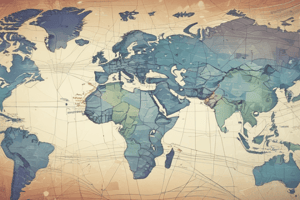Podcast
Questions and Answers
How does global marketing enhance customer value?
How does global marketing enhance customer value?
- By improving product benefits or reducing prices to meet local market needs. (correct)
- By focusing solely on cost reduction strategies.
- By reducing the need for market research.
- By standardizing product offerings across all markets.
Which strategy best exemplifies global localization?
Which strategy best exemplifies global localization?
- Maintaining consistent product branding to ensure global recognition.
- Offering products at a uniform global price point to simplify financial planning.
- Implementing the same distribution channels across all international markets.
- Adapting marketing communications to align with cultural value of the targeted country. (correct)
How do 'economies of scale' serve as a rationale for global marketing?
How do 'economies of scale' serve as a rationale for global marketing?
- Enabling higher production volumes, which lower per-unit costs and enhance profitability. (correct)
- Allowing companies to reduce labor costs by relocating production to less developed nations.
- Providing access to governmental subsidies that support international expansion.
- Facilitating the standardization of marketing campaigns across diverse cultural contexts.
What distinguishes global marketing from single-country marketing strategies?
What distinguishes global marketing from single-country marketing strategies?
What is the major implication of 'boundaryless marketing'?
What is the major implication of 'boundaryless marketing'?
Considering the global marketing environment, how does adaptation contrast with standardization?
Considering the global marketing environment, how does adaptation contrast with standardization?
What is the primary goal of marketing relative to creating value for customers?
What is the primary goal of marketing relative to creating value for customers?
Which of these reflects a geocentric management orientation?
Which of these reflects a geocentric management orientation?
What makes global marketing more critical for companies based in smaller domestic markets?
What makes global marketing more critical for companies based in smaller domestic markets?
How did the global financial crisis of 2008 impact global marketing strategies?
How did the global financial crisis of 2008 impact global marketing strategies?
Which of the following accurately embodies the concept of 'ethnocentrism' as a restrictive force in global marketing?
Which of the following accurately embodies the concept of 'ethnocentrism' as a restrictive force in global marketing?
How do multilateral trade agreements act as driving forces in global marketing?
How do multilateral trade agreements act as driving forces in global marketing?
What is the role of Research and Development (R&D) in global marketing?
What is the role of Research and Development (R&D) in global marketing?
How does 'Globalphobia' act as a restrictive force affecting global integration and global marketing?
How does 'Globalphobia' act as a restrictive force affecting global integration and global marketing?
In what way might national controls impede global marketing efforts?
In what way might national controls impede global marketing efforts?
How does McDonald's demonstrate adaptation in its global marketing strategy?
How does McDonald's demonstrate adaptation in its global marketing strategy?
Why is the 'transfer of experience' an advantage for companies engaging in global marketing?
Why is the 'transfer of experience' an advantage for companies engaging in global marketing?
How does a 'uniform global image' benefit a company's global marketing efforts?
How does a 'uniform global image' benefit a company's global marketing efforts?
From a management orientation perspective, how does a polycentric approach differ from an ethnocentric approach in global marketing?
From a management orientation perspective, how does a polycentric approach differ from an ethnocentric approach in global marketing?
How have transportation and communication improvements acted as driving forces in global marketing?
How have transportation and communication improvements acted as driving forces in global marketing?
Flashcards
What is Global Marketing?
What is Global Marketing?
Applying marketing strategies internationally, adapting to cultural, economic, and legal differences.
Global Marketing Value Creation
Global Marketing Value Creation
Creating value by improving benefits or reducing prices for international customers.
Accessing New Markets
Accessing New Markets
Expanding to new regions for more customers and increased revenue.
Accessing Global Resources
Accessing Global Resources
Signup and view all the flashcards
Competing with Lower-Cost Rivals
Competing with Lower-Cost Rivals
Signup and view all the flashcards
Economies of Scale
Economies of Scale
Signup and view all the flashcards
Transfer of Experience
Transfer of Experience
Signup and view all the flashcards
Uniform Global Image
Uniform Global Image
Signup and view all the flashcards
Global Marketing Strategy
Global Marketing Strategy
Signup and view all the flashcards
Globalization (Standardization)
Globalization (Standardization)
Signup and view all the flashcards
Global Localization (Adaptation)
Global Localization (Adaptation)
Signup and view all the flashcards
Standardization (Branding)
Standardization (Branding)
Signup and view all the flashcards
Adaptation (Localization)
Adaptation (Localization)
Signup and view all the flashcards
Goal of Marketing
Goal of Marketing
Signup and view all the flashcards
Boundaryless Marketing
Boundaryless Marketing
Signup and view all the flashcards
Ethnocentric Orientation
Ethnocentric Orientation
Signup and view all the flashcards
Polycentric Orientation
Polycentric Orientation
Signup and view all the flashcards
Regiocentric Orientation
Regiocentric Orientation
Signup and view all the flashcards
Geocentric Orientation
Geocentric Orientation
Signup and view all the flashcards
Globalphobia
Globalphobia
Signup and view all the flashcards
Study Notes
- Global marketing encompasses introducing products and services to international markets.
Regular Marketing vs. Global Marketing
- Regular marketing focuses on a single market.
- Global marketing focuses on multiple countries.
- Global marketing involves adapting to different cultural, economic, and legal environments worldwide.
Global Marketing Strategies
- Global marketing strategies create customer value by improving benefits or reducing prices.
- Enhancing product quality and features increases customer value in international markets.
- Expanding ways to reach customers is achieved through e-commerce and retailers.
- Improving advertising and customer interactions engages global audiences through targeted cultural preferences.
- Reducing direct costs (lowering prices) or non-monetary costs increases convenience and simplifies product usage.
- Value of a product/service = Benefits/Price
- Higher value occurs when benefits increase or prices decrease.
- Lower value: Price is too high relative to perceived benefits.
- Companies boost value by refining product quality, customer experience, and pricing to suit diverse markets.
Reasons for Global Marketing
- Growth: Access new markets, customers, and revenue.
- Access to resources: Source raw materials, labor, or technology internationally at lower costs.
- Survival: Compete with lower-cost competitors due to increased access to resources.
- Other Advantages
- Increased access to resources helps businesses stay competitive with cheaper labor/production costs internationally.
- Economies of scale: Higher production volumes reduce per-unit costs and boost profitability.
- Transfer experience: Apply successful strategies to other markets, increasing efficiency.
- Uniform global image: An international presence builds brand recognition and trust.
Single Country vs. Global Marketing Strategies
- Single Country Marketing Strategy involves using a single target market strategy and marketing mix development (product, price, promotion, place).
- Global Marketing Strategy:
- Global market participation is part of a global marketing strategy.
- Marketing mix development includes standardization or adaptation of the 4 P's.
- Focus marketing activities and coordination of marketing activities.
- Integrates competitive moves.
- Global marketing means widening business scopes to scan the world for opportunities and mitigate threats.
- Global marketing extends beyond operating in all 200+ country markets.
Standardization
- Standardization involves developing standardized products for global marketing with a uniform marketing mix.
- Standardization focuses on mass marketing.
Adaptation
- Adaptation mixes standardization with customization.
- The goal of adaptation is to minimize costs while maximizing satisfaction.
- Adaptation is an essence of segmentation.
- Adaptation uses a think globally, act locally strategy.
- Coca-Cola adapts its branding and design to maintain a consistent global identity.
- Adaptation includes modifying for local languages, cultural preferences, and reading styles.
- Balance standardization with adaptation to maintain recognition while appealing to different markets.
Goals of Marketing
- Surpass competition to create perceived customer value.
- The value equation serves as the guideline.
Importance of Global Marketing
- U.S. companies: 75% of total world market for goods and services lies outside the country.
- Coca-Cola: 75% of operating income occurs, and 2/3 of profits are generated outside North America.
- Japanese companies: 85% of their market is outside the country.
- German companies: 94% of market potential exists outside of Germany.
Overview of Marketing
- Marketing is a distinct functional area of business from operations and finance.
- Central marketing tools: product, price, promotion, and place.
- Marketing is a firm's value chain activity.
- Boundaryless marketing involves marketers in all value-related decisions.
- Boundaryless marketing aims to eliminate communication barriers between marketing and other business functions.
- Implement boundaryless marketing to ensure market orientation permeates all value-creating activities.
McDonald’s Global Marketing
- Product: McAloo Tikka potato burger(India), Big Mac (standard)
- Promotion: Slang Macca’s (Australia), MakDo (Philippines), Brand Name (standard).
- Place: Home delivery(India), Swiss rail system dining cars, Free-standing (standard).
- Price: Big Mac $3.54 in US & Turkey (standard), $5.79 (Switzerland), $1.83 (China).
Management Orientations
- Ethnocentric: Home country is superior and only sees similarities in other countries.
- Ethnocentricity believes products and practices successful at home are universally successful.
- Ethnocentricity leads to a standardized or extension approach.
- Polycentric: The belief each country is unique.
- Subsidiaries develop unique business and marketing strategies for each country.
- Polycentric is referred to as multinational.
- Polycentricity leads to a localized or adaptation approach adapting products to local markets.
- Regiocentric: A region is the relevant geographic unit (e.g., NAFTA, European Union).
- Companies serve markets throughout the world on a regional basis.
- Geocentric: The entire world is a potential market.
- Geocentric strives for integrated global strategies.
- Geocentric is known as a global or transitional company.
- Maintains association with the headquarters country.
- Pursues serving world markets from single country or sources globally to focus on only select country markets.
- Geocentricity leads to a combination of extension and adaption elements.
Driving Forces in Global Marketing
- Multilateral trade agreements reduce trade barriers.
- Market needs and information revolution, driven by globalization and digital access, make consumer preferences more similar.
- Transportation and communication improvements speed shipping and communication.
- Product development costs: Expensive research and development spreads across global markets.
- Quality Global marketing funds R&D, improving product quality.
- World economic: 2008 affected markets and consumer spending.
- Growing middle class creates demand in emerging markets (China, India, Brazil).
- Free markets movement reduces restrictions, encouraging global trade.
Restricting Forces Affecting Global Integration
- Management myopia and organizational culture fail to see global opportunities due to a narrow or short-term mindset.
- Ethnocentrism: Belief that one's country/culture is superior, limiting adaptation to foreign markets.
- National controls: Governments restrict foreign businesses.
- Limited market access and entry is related to tariffs, trade barriers, and local laws make market entry difficult.
- Opposition to Globalization causes concerns about cultural or economic impact.
- Globalphobia includes fear of globalization, job losses, cultural changes, or foreign control.
Studying That Suits You
Use AI to generate personalized quizzes and flashcards to suit your learning preferences.




